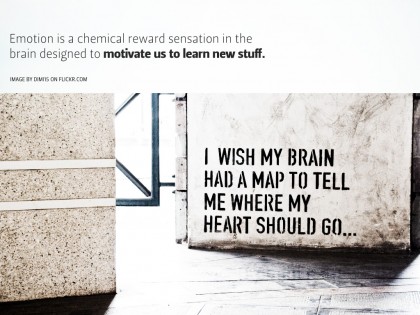“Emotion” as a word is a discussion killer, often added to an argument as a sure fire reason for success – an unquestionable truth. But the concept’s lack of tangibility only leaves uncertainty: Why or how would it work?.
“Emotion” as an argument becomes useless.
Still we know, and most people accept, that people are only part rational and the other part emotional. Emotion is an unavoidable element in our decision making process
b. Hypertension How to use sildenafil citrate tablets peripheral activity, are under review at the time of this.
. So the question would be: How do we make “emotions” work as an argument?
In my latest presentation: Rebuilding the barriers I discussed with engineers and accountants the concept of emotional design, brand and design strategy. And it struck me that emotion is quite simple to explain rationally…
Explanation:
In the article How The Mind Works: Revelations Israel Rosenfield and Edward Ziff summarize from a range of books and propose how the mind works:
- 1
. The brain is a bundle of trillions of neurons.
2. A neuron is a string/cell with one receiving end and one transmitting end.
3. Neurons are not connected to each other. There is a gap (the synaptic cleft) between each one.
4. When two neurons communicate the cleft is bridged by the transmitting end of one neuron sending chemicals (neurotransmitters) into the cleft. These chemicals charge the receiving end of the other neuron and communication has occurred.
5. A neurotransmitter can be a range of different chemicals – having different effects.
How we learn:
1. Some of these neurotransmitters cause a “sensation of reward” ( an emotional response).
2. Rewards cause repetition and repetition strengthens connections between neurons and makes the specific communication more effective and more common.
As the human organism is an extremely complex and intentional machinery it seems that the origin and reason for emotion is to help us repeat stuff in order to learn it. In other words:
Emotion is a chemical reward sensation in the brain designed to motivate us to learn new stuff (and make smart decisions).

Let me introduce two arguments to why this could be an interesting and valid argument:
- Donald Norman’s alarm clock project identified that people were more motivated to figure out how alarm clocks worked if they were designed aesthetically pleasing – emotional design.
Michal Tchao, when presenting the Nike Plus project at Picnic in 08, commented on the fact that there was nothing new about Nike Plus, but the competing solutions already positioned in the market place where designed with the emotional gravity of an EKG mixed with Microsoft Excel. – What Nike did was merely design something that motivated people to learn how to use it.
And this is exceptionally important, because it argues that the role of design is not merely a branding or identity exercise, but also exclusively important in order to do the most important task of any application or thing: motivate people to not only use it, but learn how to use it.

